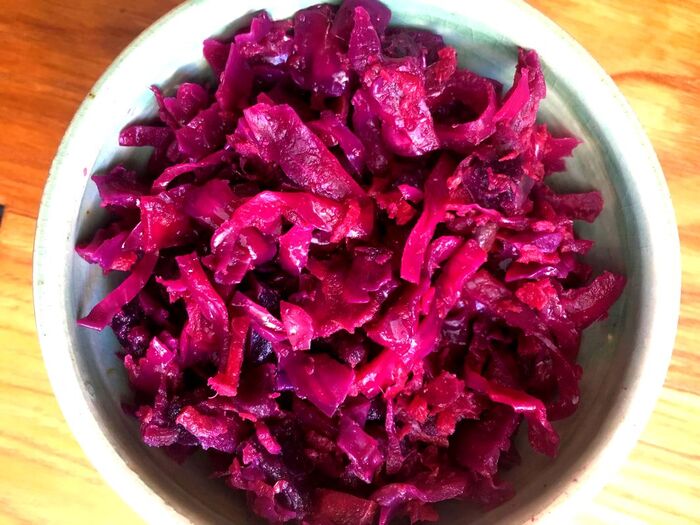|
I am always looking for new flavors of sauerkraut to make, and I just so happened to have some extras of these goodies that needed to get used up in my fridge. Inspired by a juice blend at a health food restaurant and juice bar I worked at in college, the delicious combination of carrots, apples, and ginger add a nice sweetness to balance out the tart and slightly bitter flavors of the sauerkraut itself. Adding fruit to fermented vegetables is nothing new, and is a common addition to some types of kim chi in Korea, which also sparked inspiration for this combo. When adding fruit to your ferments, be sure to keep a closer eye on your jars than usual, as the higher sugar content of this kraut may tend toward mold or kahm yeast. Keep everything submerged below the brine to prevent this, shorten the fermentation time a bit, and you are good to go. Feel free to use red or green cabbage here and scale the recipe up or down as desired, always keeping the ratio of salt to vegetables 1 tsp to 1 lb. Serve this kraut on a brat, alongside breakfast sausage, on a toasted ham and cheese sandwich, mixed in with coleslaw, tossed in a green salad, or even use as a post-cooking addition to crispy roasted potatoes. Anywhere you want to add both sweet and tart flavors, this is your guy. Carrot-Apple-Ginger Kraut Makes 2 quarts 1 medium head cabbage, about 2-3 lbs, shredded 1 lb carrots, grated 1/2 lb apples, finely diced 2" fresh ginger root, grated (or to taste) 4 1/2 tsp sea salt (may need a bit more or less; use ratio of 1 tsp salt per lb of vegetables) In a large mixing bowl, set on top of a kitchen scale and tared, combine the cabbage, carrots, apples and ginger. Based on this weight, add the corresponding amount of salt, using the ratio 1 tsp fine sea salt to 1 lb of vegetables. Stir in the salt and massage into the veggie mix. Massage the salt in for 5-10 minutes, until the cabbage softens significantly, the volume of the veggies reduces by about half, and juice is easily wrung out of the mixture when squeezed. Pack the salted cabbage mix into glass jars or a ceramic fermentation crock. Press the mixture in tightly, allowing you to fit as much as possible in the vessel, while also removing any air bubbles present. Pack and press until the jar is filled to its shoulders, not all the way to the top, and until a distinct layer of brine rises above the vegetables. If not much brine is present, continue with the process and check the jar after 24 hours. By this time, the salt will likely have pulled more water out of the vegetables and fruit, creating plenty of brine. Place a fermentation weight on top of the mixture, keeping it submerged well below brine throughout the fermentation process. Put a non-reactive lid on top, screwing on very loosely to prevent breakage. Set on your counter at room temperature, out of direct light or extreme temperatures, and let sit to ferment for 5-10 days. Check regularly for mold or yeast, pressing the weight to keep the veggies submerged if needed. When done fermenting, remove the weights and transfer the kraut to the fridge. It will keep for about 1 year under refrigeration.
0 Comments
Leave a Reply. |
Brine & Broth
I am a gut health-focused nutritionist and online health coach based in Southwest Wisconsin. My recipes and philosophies center around traditional, nutrient-dense foods that support robust gut health. Archives
May 2022
Categories |



 RSS Feed
RSS Feed
